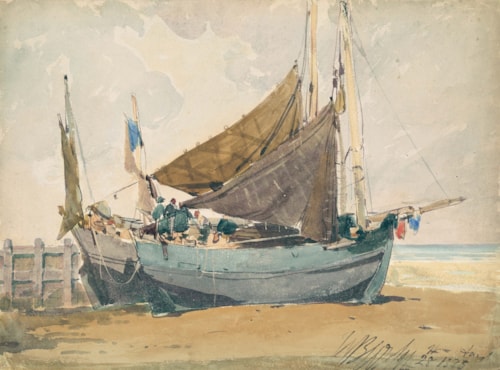
William Roxby BEVERLEY
Richmond 1811 - Hampstead 1889
Biography
The son and grandson of actors and theatre managers, William Roxby Beverley began his career as a painter of scenery for the theatre and continued to work in this field throughout his life. Indeed, his reputation was established by his renown as a scene painter, and in particular his skill in rendering atmospheric effects. (An obituary published in the Daily Telegraph in 1889 described Beverley as the ‘long acknowledged chief and doyen of English scenic artists’, although the author also noted his ‘noble water-colours done in leisure hours.’) Beverley began to produce landscape watercolours under the influence of Clarkson Stanfield, also a former scene painter, whom he joined on sketching tours, as well as Richard Parkes Bonington. Although Beverley began exhibiting his marine watercolours from 1831 onwards, he continued to make his living as both a scene painter at the Theatre Royal in Manchester and, occasionally, as an actor. By 1846 he had settled in London, and was engaged as scenic director at several theatres, notably at the Lyceum, Covent Garden and Drury Lane. By comparison with many of his fellow artists, however, Beverley produced relatively few watercolours, since he was kept busy by the demands on his time as a theatrical painter and scenographer. Nevertheless, as one early critic had noted, ‘Beverley painted water-colour pictures of rare and delicate beauty, works which alone should suffice to win for him a place in the front rank among our masters of water-colour art.’
Beverley worked for his entire career in England and Scotland, although he is known to have visited France and Switzerland. He was particularly fond of coastal scenes and depictions of such port towns and fishing communities as Scarborough, Eastbourne, Hastings and Sunderland, and also painted views in London, the upper Thames valley and the Lake District. In many of his watercolours, there is a particular interest in skies and atmospheric effects; a legacy of his training as a scene painter. Beverley regularly exhibited his landscape watercolours, which were almost always of English coastal scenes, at the Royal Academy between 1865 and 1880. He also showed his work at such commercial galleries as the Dudley Gallery and charged up to £400 for some of his finished watercolours. Watercolours by Beverley are today in the collections of the Victoria Art Gallery in Bath, the National Galleries of Scotland in Edinburgh, the Leeds Art Gallery in Leeds, Harrow School and the Victoria and Albert Museum in London, and elsewhere.


